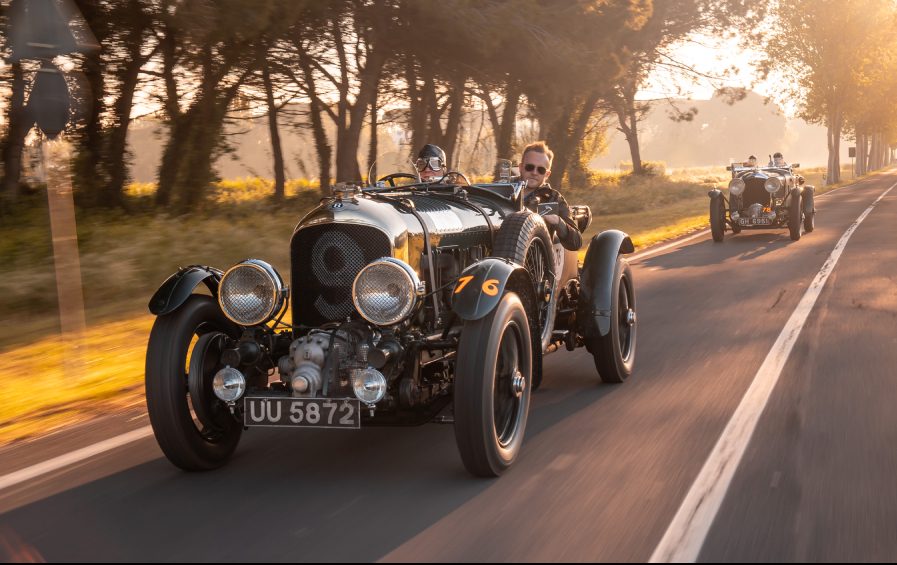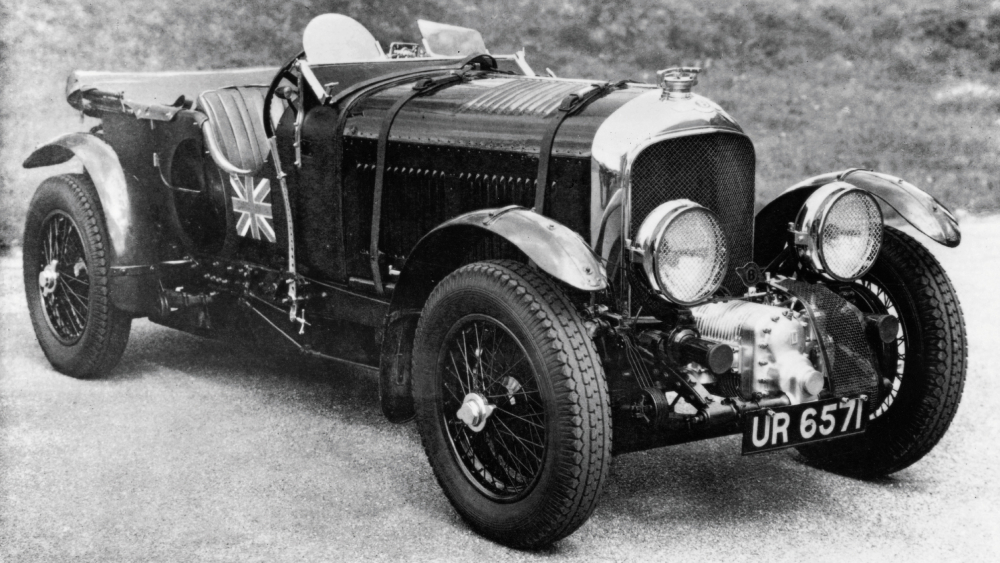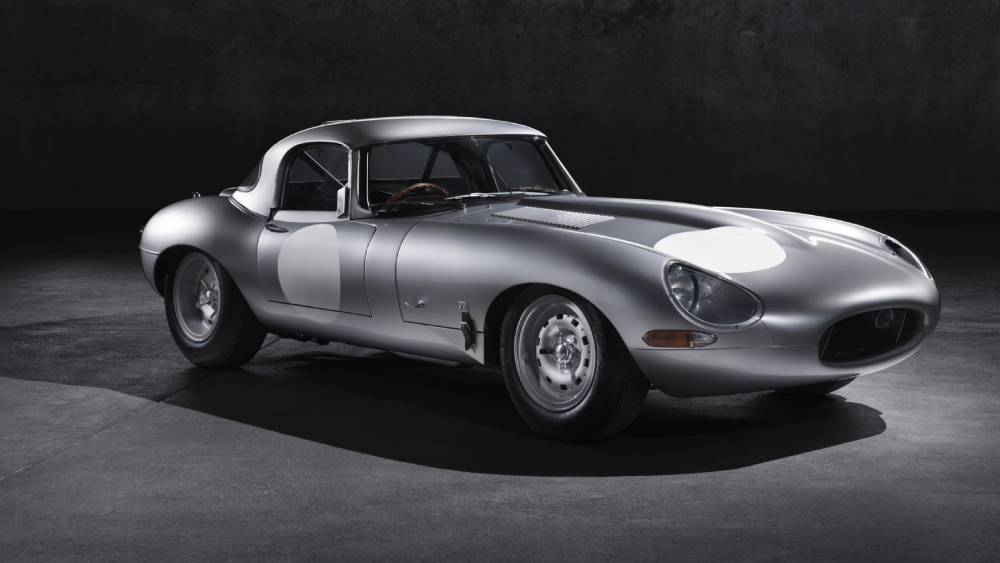
Robb Read: The Rise Of Continuation Cars
Are these reproductions the stuff of collectors’ dreams or just an elaborate marketing ruse?
Related articles
The letter, dated March 20, 2020, was addressed to Adrian Hallmark, chairman and CEO of British automaker Bentley. It began with a nostalgic recap of the marque’s storied triumphs in races a century ago, before getting, politely, to the point.
“Understandably, over many years, Bentley Motors’ marketing department has sought to maximise this remarkable heritage,” the letter reads. “Bentley Motors Ltd. has often had recourse to supportive private owners—such as ourselves—to provide one or more of our genuine period cars for various company promotions and events which we have willingly encouraged. Against such a supportive background, we are now writing to express our shared concern and dismay upon hearing of your company’s apparent plans to build and market a batch of 12 replica ‘Blower’ Bentleys for premium-price sale.”
What gave the correspondence unusual gravitas was that the 10 signatories are among the most prominent car collectors in the world, including fashion designer Ralph Lauren, JCB construction-equipment billionaire Lord Bamford, California real-estate developer John Mozart, Walmart heir Rob Walton and international classic-car consultant Simon Kidston. They described their group as “lifelong enthusiasts for the Bentley marque” and concluded, with commendable snark, “Marketing people—in their understandable enthusiasm—often fail to grasp matters not only of detail, but also of basic truth. We urge you to please not squander time, funding, energy and the Bentley brand’s reputation upon the recently announced batch of 12 facsimile cars, cars that would serve only to dilute that special admiration and awe that can only come from viewing and embracing the genuine article. To do otherwise would be
to pervert a glorious history.”
To understand what’s at stake here, let’s take a step back. Gearheads have been dabbling with kit cars and aftermarket replicas since the 1950s, when cheaper fibreglass bodies and inexpensive chassis flooded the market. But this new breed is on a different level entirely. Unlike those knock-offs, continuation cars are made, or officially licensed, by the original manufacturer and painstakingly constructed to the same period specifications as the initial models, save for certain contemporary safety and handling features. Notably, their chassis and engine numbers often follow their predecessors sequentially, effectively continuing a bygone model’s production.
The genesis for Bentley’s endeavour is the second of four machines built and raced by Sir Henry “Tim” Birkin at Le Mans early last century. Birkin’s “No. 2” Blower is owned by Bentley, though similar examples—50 production cars were made—can fetch anywhere from approx. $6.5 million to approx. $26 million.
Birkin was one of the celebrated Bentley Boys, gentlemen racers who piloted the marque to first-place finishes at the 24 Hours of Le Mans from 1927 through 1930. The winning drive team that final year was Woolf Barnato and Glen Kidston, Simon’s late uncle, which helps explain the nephew’s misgivings about tinkering with legacy.
“Brands that are doing well shouldn’t need to resort to raiding their back catalogues, and I don’t believe it reflects well on them,” says Kidston, steward to his family’s own impressive motoring assemblage and consultant for others in the arena. “It detracts from the rarity of the originals and effectively undermines the real heritage of the brand. We’re not singling out Bentley. I think the same is true of others who have jumped on the ‘authentic replica’ bandwagon.”
There are longer-term ramifications, too, he says. “It creates the potential for confusion in the future over what is real and what is not. Anything built purely to be a collector’s item rarely becomes one, long-term. There is no integrity of purpose to a new copy whose sole aim for the manufacturer is to make money. It has no intrinsic value. Only age, history and authenticity confer that magic.” Kidston compares continuation cars to “trying to replicate a vintage wine just by analysing its components and passing the resulting mix off as ‘new old vintage.’ ”
Others share his concern. Bruce Meyer, a director of the Petersen Automotive Museum and the owner of a large stable of noteworthy vehicles, recognises that continuations allow those who can’t afford the original to get in the game, but “if you’re a serious collector, you want to stay away from continuations. They will contaminate the authenticity of your entire collection.”
What fuels the worth of any collectible is scarcity, so clearly when a diminishing supply begins to replenish, alarm grows as perceived value dips. Take the Porsche 993, the fourth generation of the 911 model. As the last iteration to feature the marque’s air-cooled flat-six engine, it has become highly coveted by Porschephiles and aftermarket tuners, who have driven prices as high as seven figures in some cases. Hypothetically, if Porsche brought the air-cooled engine back into production, the 993 would become an asterisk instead of an exclamation point on a connoisseur’s wish list—the rarity bubble would burst.
Those in the pro camp see things a little differently. For the leader of Bentley’s project, Tim Hannig, the decision to revisit the Blower was a pragmatic response to increase a specific vehicle’s longevity. “The original car is used a lot”—for promotions, events, VIP rides and the like—“probably more than it should be according to its age and value,” he tells
Robb Report. “The idea was born to create a toolroom copy to do a lot of the work.” Once the word got out, there were requests from the Bentley faithful for a few more.
The process of building a period-correct facsimile from scratch involves what Hannig refers to as “industrial archaeology”: his team scoured the archives for outlines and documentation of materials, stripped major portions of the car, then completely scanned it to generate a digital model. One of the greatest challenges, he says, was the 4.9-metre sheet-metal chassis, which relied on old-fashioned hammer work and a machine dating to 1899.
“We’re using modern technologies to get to our target but traditional methods to create the actual assets that go on the car,” he says. “If we waited a bit longer, the craftsmanship skills would definitely be gone. It’s a fantastic way of not just storing the ashes of a period but really keeping the fire glowing, even on a small scale.”
A pioneer of the trend was Jaguar, which opened its restoration and heritage centre, Jaguar Classic, in 2014. Re-creating a benchmark car was the first order of operation, since it would best showcase the division’s capabilities. But the idea to resurrect the past was also based on a sense of unfinished business.
“For a number of different reasons, the planned production runs of some of our most iconic vehicles weren’t always completed in period,” says Dan Pink, director of Jaguar Classic. “Our continuation programs have allowed us to correct this. It’s also a valuable learning exercise for our team, cascading the knowledge and expertise from previous generations to get under the skin of our prized machines.”
The focus thus far has been on three models from the marque’s golden age in the 1950s and ’60s: the D-type, the XKSS and the E-type. In 1963, Jaguar planned to build 18 copies of a Special GT E-type, but only 12 were completed—that is, until 2016, when the final six examples were finished to such faithful reproduction that they qualified for historic-racing certification through the Fédération Internationale de l’Automobile.
Jaguar then returned to the XKSS, a street version of its D-type racer. Only 16 of the initial 25 cars survived a factory fire in 1957; the last of the nine replacements was completed 61 years
later, in 2018. Jaguar also announced production of 25 “new” D-types, some of which are still in the works, though already pre-sold. (The XKSS and E-type continuations have all been delivered.)
One reason for the demand is that original concours-quality examples of the D-type command in the neighbourhood of approx. $11.5 million (although one fetched approx. $27 million at auction in 2016), while the contemporaries sell for roughly one-ninth that price. As Meyer noted earlier, continuation cars can be a gateway drug for those who don’t yet have the resources to invest in the real thing. Or for those who have nearly unlimited funds, they’re a way to protect a more valuable investment in an original: a niche position to be sure, but one that holds outsize sway in the most rarefied stratum of the car-collecting world.
“They provide collectors the freedom to enjoy their cars without the anxiety and cost of running the originals,” says Peter Mullin, another Petersen board member and founder of the Mullin Automotive Museum, also in Southern California. “The last thing we would want is to wreck a 70-year-old fender or scratch an original paint job. For daily or even weekend drives, continuation cars are the best option.”
Mullin’s perspective is backed by Paul Spires, president of Aston Martin Works, the marque’s restoration and preservation department. Spires readily admits that there were those in the Aston community worried about classics being revisited, but “when they came here and saw the quality, passion and dedication of the team involved, their fears were very quickly allayed,” he says. “Some owners of original cars went on to purchase one or more continuations themselves.”
After re-creating 25 examples of Aston’s famed 1959–63 DB4 GT in 2017 (priced at approx. $2.5 million apiece), Spires and co. have revisited the DB4 GT Zagato of the early 1960s, with a run of 19 new additions, and are currently focused on reviving one of the most famous cars in the world—the DB5 that the late Sir Sean Connery drove in the 1964 James Bond film, Goldfinger. The 25 DB5 Goldfinger Continuation cars will be equipped with the same embellishments used by 007, including a smoke-screen system, revolving license plates and bullet-resistant glass. But while the new release costs approx. $4.7 million, one of the actual coupes used to promote the film franchise in the mid-1960s sold for approx. $8.3 million at auction in August 2019, during Monterey Car Week in California. You can, it seems, put a price on provenance.
But for many brands and collectors alike, the philosophy behind continuation cars is about more than money. Mullin believes continuations “reignite a passion among younger enthusiasts and further the hobby,” and he’s right, at least according to Stateside constructor Lance Stander and his team at Superformance. It’s the only outside entity licensed to recreate benchmark 289 and 427 variants of the classic Shelby Cobra—developed by the late Carroll Shelby, who\subsequently endorsed their work—as well as the GT40s that Shelby helped develop for Ford. “We have buyers in their late 20s and early 30s,” Stander says. “One designs computer games and has bought two GT40s and a Cobra from us.”
If collectors can’t decide whether these cars are an abomination or highly desirable, then perhaps the market will.
“Nobody knew what was going to happen as the global economy changed back in March, but right now the market [for collectibles] is very strong,” says Brian Rabold, vice president of valuation services at Hagerty Classic Insurance, experts in high-end automotive coverage. According to Hagerty’s estimates, many of the aforementioned originals increased in price or remained static after the newbies’ appearance on the scene, notwithstanding the uncertainty of the past 12 months (see “Time Will Tell” opposite page).
So the value of the originals has remained strong. But so too has that of the newcomers. Auction house RM Sotheby’s had an example from each of the three Jaguar continuations cross the block in October 2020. The least expensive sold for approx. $1.71 million and the most for approx. $2.6 million—evidence, surely, of an audience willing to make room for these cars in the canon. “These [continuation] cars are part of their own distinct category—not replicas, but not a classic original,” says Alexander Weaver, car specialist at RM Sotheby’s. “Interestingly, some are even rarer than the initial model”—such as Jaguar’s D-type continuation, which saw just a third of the original’s 75-unit production—“making them that much more desirable.”
Could it be that continuation cars are just that: a way of maintaining a legacy that, without new impetus, would wither and die? Do we want a future where a priceless old Blower turns to rust under a cover because there are no longer technicians capable of maintaining it, even if that deterioration drives the car’s valuation up instead of down? Perhaps the basic truth is simpler. While this may not be the case forever—and while they may not care to admit it—could it be that right now everyone with interests in the continuation game gets to win . . . whatever they write in their letters?
Subscribe to the Newsletter
Recommended for you
First Drive: The Lotus Emeya Targets Porsche, Mercedes, and Lucid With Its 70 kw Performance
What the all-electric sedan lacks in cohesive styling is more than made up for in muscular athleticism.
By Tim Pitt
July 22, 2024
Why BMW’s First Electric Cars Are Future Classics
Many things still feel contemporary about the BMW i3 and i8.
July 11, 2024
You may also like.
By Josh Bozin
24/07/2024
You may also like.
5 Lounge Chairs That Add Chic Seating to Your Space
Daybeds, the most relaxed of seating solutions, offer a surprising amount of utility.
Chaise longue, daybed, recamier, duchesse brisée—elongated furniture designed for relaxing has a roster of fancy names. While the French royal court of Louis XIV brought such pieces to prominence in fashionable European homes, the general idea has been around far longer: The Egyptian pharaohs were big fans, while daybeds from China’s Ming dynasty spurred all those Hollywood Regency fretwork pieces that still populate Palm Beach living rooms. Even Mies van der Rohe, one of design’s modernist icons, got into the lounge game with his Barcelona couch, a study of line and form that holds up today.
But don’t get caught up in who invented them, or what to call them. Instead, consider their versatility: Backless models are ideal in front of large expanses of glass (imagine lazing on one with an ocean view) or at the foot of a bed, while more structured pieces can transform any corner into a cozy reading nook. Daybeds may be inextricably linked to relaxation, but from a design perspective, they put in serious work.

Emmy, Egg Collective
In designing the Emmy chaise, the Egg Collective trio of Stephanie Beamer, Crystal Ellis and Hillary Petrie, who met as students at Washington University in St. Louis, aimed for versatility. Indeed, the tailored chaise looks equally at home in a glass skyscraper as it does in a turn-of-the-century town house. Combining the elegance of a smooth, solid oak or walnut frame with the comfort of bolsters and cushioned upholstery or leather, it works just as well against a wall or at the heart of a room. From around $7,015; Eggcollective.com
 Plum, Michael Robbins
Plum, Michael Robbins
Woodworker Michael Robbins is the quintessential artisan from New York State’s Hudson Valley in that both his materials and methods pay homage to the area. In fact, he describes his style as “honest, playful, elegant and reflective of the aesthetic of the Hudson Valley surroundings”. Robbins crafts his furniture by hand but allows the wood he uses to help guide the look of a piece. (The studio offers eight standard finishes.) The Plum daybed, brought to life at Robbins’s workshop, exhibits his signature modern rusticity injected with a hint of whimsy thanks to the simplicity of its geometric forms. Around $4,275; MichaelRobbins.com

Kimani, Reda Amalou Design
French architect and designer Reda Amalou acknowledges the challenge of creating standout seating given the number of iconic 20th-century examples already in existence. Still, he persists—and prevails. The Kimani, a bent slash of a daybed in a limited edition of eight pieces, makes a forceful statement. Its leather cushion features a rolled headrest and rhythmic channel stitching reminiscent of that found on the seats of ’70s cars; visually, these elements anchor the slender silhouette atop a patinated bronze base with a sure-handed single line. The result: a seamless contour for the body. Around $33,530; RedaAmalou
Dune, Workshop/APD
From a firm known for crafting subtle but luxurious architecture and interiors, Workshop/APD’s debut furniture collection is on point. Among its offerings is the leather-wrapped Dune daybed. With classical and Art Deco influences, its cylindrical bolsters are a tactile celebration, and the peek of the curved satin-brass base makes for a sensual surprise. Associate principal Andrew Kline notes that the daybed adeptly bridges two seating areas in a roomy living space or can sit, bench-style, at the foot of a bed. From $13,040; Workshop/ APD
Sherazade, Edra
Designed by Francesco Binfaré, this sculptural, minimalist daybed—inspired by the rugs used by Eastern civilizations—allows for complete relaxation. Strength combined with comfort is the name of the game here. The Sherazade’s structure is made from light but sturdy honeycomb wood, while next-gen Gellyfoam and synthetic wadding aid repose. True to Edra’s amorphous design codes, it can switch configurations depending on the user’s mood or needs; for example, the accompanying extra pillows—one rectangular and one cylinder shaped— interchange to become armrests or backrests. From $32,900; Edra
You may also like.
By Josh Bozin
24/07/2024
22/07/2024
Watches & Wonders 2024 Showcase: Hermès
We head to Geneva for the Watches & Wonders exhibition; a week-long horological blockbuster featuring the hottest new drops, and no shortage of hype.
With Watches & Wonders 2024 well and truly behind us, we review some of the novelties Hermès presented at this year’s event.
—
HERMÈS

Moving away from the block colours and sporty aesthetic that has defined Hermès watches in recent years, the biggest news from the French luxury goods company at Watches & Wonders came with the unveiling of its newest collection, the Hermès Cut.
It flaunts a round bezel, but the case middle is nearer to a tonneau shape—a relatively simple design that, despite attracting flak from some watch aficionados, works. While marketed as a “women’s watch”, the Cut has universal appeal thanks to its elegant package and proportions. It moves away from the Maison’s penchant for a style-first product; it’s a watch that tells the time, not a fashion accessory with the ability to tell the time.
Hermès gets the proportions just right thanks to a satin-brushed and polished 36 mm case, PVD-treated Arabic numerals, and clean-cut edges that further accentuate its character. One of the key design elements is the positioning of the crown, boldly sitting at half-past one and embellished with a lacquered or engraved “H”, clearly stamping its originality. The watch is powered by a Hermès Manufacture movement H1912, revealed through its sapphire crystal caseback. In addition to its seamlessly integrated and easy-wearing metal bracelet, the Cut also comes with the option for a range of coloured rubber straps. Together with its clever interchangeable system, it’s a cinch to swap out its look.
It will be interesting to see how the Hermès Cut fares in coming months, particularly as it tries to establish its own identity separate from the more aggressive, but widely popular, Ho8 collection. Either way, the company is now a serious part of the dialogue around the concept of time.
—
Read more about this year’s Watches & Wonders exhibition at robbreport.com.au
You may also like.
22/07/2024
Living La Vida Lagerfeld
The world remembers him for fashion. But as a new tome reveals, the iconoclastic designer is defined as much by extravagant, often fantastical, homes as he is clothes.
“Lives, like novels, are made up of chapters”, the world-renowned bibliophile, Karl Lagerfeld, once observed.
Were a psychological-style novel ever to be written about Karl Lagerfeld’s life, it would no doubt give less narrative weight to the story of his reinvigoration of staid fashion houses like Chloe, Fendi and Chanel than to the underpinning leitmotif of the designer’s constant reinvention of himself.
In a lifetime spanning two centuries, Lagerfeld made and dropped an ever-changing parade of close friends, muses, collaborators and ambiguous lovers, as easily as he changed his clothes, his furniture… even his body. Each chapter of this book would be set against the backdrop of one of his series of apartments, houses and villas, whose often wildly divergent but always ultra-luxurious décor reflected the ever-evolving personas of this compulsively public but ultimately enigmatic man.
With the publication of Karl Lagerfeld: A Life in Houses these wildly disparate but always exquisite interiors are presented for the first time together as a chronological body of work. The book indeed serves as a kind of visual novel, documenting the domestic dreamscapes in which the iconic designer played out his many lives, while also making a strong case that Lagerfeld’s impact on contemporary interior design is just as important, if not more so, than his influence on fashion.

In fact, when the first Lagerfeld interior was featured in a 1968 spread for L’OEil magazine, the editorial describes him merely as a “stylist”. The photographs of the apartment in an 18th-century mansion on rue de Université, show walls lined with plum-coloured rice paper, or lacquered deepest chocolate brown in sharp contrast to crisp, white low ceilings that accentuated the horizontality that was fashionable among the extremely fashionable at the time. Yet amid this setting of aggressively au courant modernism, the anachronistic pops of Art Nouveau and Art Deco objects foreshadow the young Karl’s innate gift for creating strikingly original environments whose harmony is achieved through the deft interplay of contrasting styles and contexts.
Lagerfeld learned early on that presenting himself in a succession of gem-like domestic settings was good for crafting his image. But Lagerfeld’s houses not only provided him with publicity, they also gave him an excuse to indulge in his greatest passion. Shopping!
By 1973, Lagerfeld was living in a new apartment at Place Saint–Sulpice where his acquisition of important Art Deco treasures continued unabated. Now a bearded and muscular disco dandy, he could most often be found in the louche company of the models, starlets and assorted hedonistic beauties that gathered around the flamboyant fashion illustrator Antonio Lopez. Lagerfeld was also in the throes of a hopeless love affair with Jacques de Bascher whose favours he reluctantly shared with his nemesis Yves Saint Laurent.

He painted the rooms milky white and lined them with specially commissioned carpets—the tawny patterned striations of which invoked musky wild animal pelts. These lent a stark relief to the sleek, machine-age chrome lines of his Deco furnishings. To contemporary eyes it remains a strikingly original arrangement that subtly conveys the tensions at play in Lagerfeld’s own life: the cocaine fuelled orgies of his lover and friends, hosted in the pristine home of a man who claimed that “a bed is for one person”.
In 1975, a painful falling out with his beloved Jacques, who was descending into the abyss of addiction, saw almost his entire collection of peerless Art Deco furniture, paintings and objects put under the auctioneer’s hammer. This was the first of many auction sales, as he habitually shed the contents of his houses along with whatever incarnation of himself had lived there. Lagerfeld was dispassionate about parting with these precious goods. “It’s collecting that’s fun, not owning,” he said. And the reality for a collector on such a Renaissance scale, is that to continue buying, Lagerfeld had to sell.
Of all his residences, it was the 1977 purchase of Hôtel Pozzo di Borgo, a grand and beautifully preserved 18th-century house, that would finally allow him to fulfill his childhood fantasies of life in the court of Madame de Pompadour. And it was in this aura of Rococó splendour that the fashion designer began to affect, along with his tailored three-piece suits, a courtier’s ponytailed and powdered coif and a coquettish antique fan: marking the beginning of his transformation into a living, breathing global brand that even those with little interest in fashion would immediately recognise.

Lagerfeld’s increasing fame and financial success allowed him to indulge in an unprecedented spending frenzy, competing with deep-pocketed institutions like the Louvre to acquire the finest, most pedigreed pearls of the era—voluptuously carved and gilded bergères; ormolu chests; and fleshy, pastel-tinged Fragonard idylls—to adorn his urban palace. His one-time friend André Leon Talley described him in a contemporary article as suffering from “Versailles complex”.
However, in mid-1981, and in response to the election of left-wing president, François Mitterrand, Lagerfeld, with the assistance of his close friend Princess Caroline, became a resident of the tax haven of Monaco. He purchased two apartments on the 21st floor of Le Roccabella, a luxury residential block designed by Gio Ponti. One, in which he kept Jacques de Bascher, with whom he was now reconciled, was decorated in the strict, monochromatic Viennese Secessionist style that had long underpinned his aesthetic vocabulary; the other space, though, was something else entirely, cementing his notoriety as an iconoclastic tastemaker.

Lagerfeld had recently discovered the radically quirky designs of the Memphis Group led by Ettore Sottsass, and bought the collective’s entire first collection and had it shipped to Monaco. In a space with no right angles, these chaotically colourful, geometrically askew pieces—centred on Masanori Umeda’s famous boxing ring—gave visitors the disorientating sensation of having entered a corporeal comic strip. By 1991, the novelty of this jarring postmodern playhouse had inevitably worn thin and once again he sent it all to auction, later telling a journalist that “after a few years it was like living in an old Courrèges. Ha!”

In 1989, de Bascher died of an AIDS-related illness, and while Lagerfeld’s career continued to flourish, emotionally the famously stoic designer was struggling. In 2000, a somewhat corpulent Lagerfeld officially ended his “let them eat cake” years at the Hôtel Pozzo di Borgo, selling its sumptuous antique fittings in a massive headline auction that stretched over three days. As always there were other houses, but now with his longtime companion dead, and his celebrity metastasising making him a target for the paparazzi, he began to look less for exhibition spaces and more for private sanctuaries where he could pursue his endless, often lonely, work.
His next significant house was Villa Jako, named for his lost companion and built in the 1920s in a nouveau riche area of Hamburg close to where he grew up. Lagerfeld shot the advertising campaign for Lagerfeld Jako there—a fragrance created in memorial to de Bascher. The house featured a collection of mainly Scandinavian antiques, marking the aesthetic cusp between Art Nouveau and Art Deco. One of its rooms Lagerfeld decorated based on his remembrances of his childhood nursery. Here, he locked himself away to work—tellingly—on a series of illustrations for the fairy tale, The Emperor’s New Clothes. Villa Jako was a house of deep nostalgia and mourning.
But there were more acts—and more houses—to come in Lagerfeld’s life yet. In November 2000, upon seeing the attenuated tailoring of Hedi Slimane, then head of menswear at Christian Dior, the 135 kg Lagerfeld embarked on a strict dietary regime. Over the next 13 months, he melted into a shadow of his former self. It is this incarnation of Lagerfeld—high white starched collars; Slimane’s skintight suits, and fingerless leather gloves revealing hands bedecked with heavy silver rings—that is immediately recognisable some five years after his death.
The 200-year-old apartment in Quái Voltaire, Paris, was purchased in 2006, and after years of slumber Lagerfeld—a newly awakened Hip Van Winkle—was ready to remake it into his last modernist masterpiece. He designed a unique daylight simulation system that meant the monochromatic space was completely without shadows—and without memory. The walls were frosted and smoked glass, the floors concrete and silicone; and any hint of texture was banned with only shiny, sleek pieces by Marc Newson, Martin Szekely and the Bouroullec Brothers permitted. Few guests were allowed into this monastic environment where Lagerfeld worked, drank endless cans of Diet Coke and communed with Choupette, his beloved Birman cat, and parts of his collection of 300,000 books—one of the largest private collections in the world.

Lagerfeld died in 2019, and the process of dispersing his worldly goods is still ongoing. The Quái Voltaire apartment was sold this year for US$10.8 million (around $16.3 million). Now only the rue de Saint-Peres property remains within the Lagerfeld trust. Purchased after Quái Voltaire to further accommodate more of his books—35,000 were displayed in his studio alone, always stacked horizontally so he could read the titles without straining his neck—and as a place for food preparation as he loathed his primary living space having any trace of cooking smells. Today, the rue de Saint-Peres residence is open to the public as an arts performance space and most fittingly, a library.
You may also like.
By Josh Bozin
24/07/2024
Watch This Space: Mike Nouveau
Meet the game-changing horological influencers blazing a trail across social media—and doing things their own way.
In the thriving world of luxury watches, few people own a space that offers unfiltered digital amplification. And that’s precisely what makes the likes of Brynn Wallner, Teddy Baldassarre, Mike Nouveau and Justin Hast so compelling.
These thought-provoking digital crusaders are now paving the way for the story of watches to be told, and shown, in a new light. Speaking to thousands of followers on the daily—mainly via TikTok, Instagram and YouTube—these progressive commentators represent the new guard of watch pundits. And they’re swaying the opinions, and dollars, of the up-and-coming generations who now represent the target consumer of this booming sector.
—
MIKE NOUVEAU

Can we please see what’s on the wrist? That’s the question that catapulted Mike Nouveau into watch stardom, thanks to his penchant for highlighting incredibly rare timepieces across his TikTok account of more than 400,000 followers. When viewing Nouveau’s attention-grabbing video clips—usually shot in a New York City neighbourhood—it’s not uncommon to find him wrist-rolling some of the world’s rarest timepieces, like the million-dollar Cartier Cheich (a clip he posted in May).
But how did someone without any previous watch experience come to amass such a cult following, and in the process gain access to some of the world’s most coveted timepieces? Nouveau admits had been a collector for many years, but moved didn’t move into horology full-time until 2020, when he swapped his DJing career for one as a vintage watch specialist.
“I probably researched for a year before I even bought my first watch,” says Nouveau, alluding to his Rolex GMT Master “Pepsi” ref. 1675 from 1967, a lionised timepiece in the vintage cosmos. “I would see deals arise that I knew were very good, but they weren’t necessarily watches that I wanted to buy myself. I eventually started buying and selling, flipping just for fun because I knew how to spot a good deal.”
Nouveau claims that before launching his TikTok account in the wake of Covid-19, no one in the watch community knew he existed. “There really wasn’t much watch content, if any, on TikTok before I started posting, especially talking about vintage watches. There’s still not that many voices for vintage watches, period,” says Nouveau. “It just so happens that my audience probably skews younger, and I’d say there are just as many young people interested in vintage watches as there are in modern watches.”
View this post on Instagram
Nouveau recently posted a video to his TikTok account revealing that the average price of a watch purchased by Gen Z is now almost US$11,000 (around $16,500), with 41 percent of them coming into possession of a luxury watch in the past 12 months.
“Do as much independent research as you can [when buying],” he advises. “The more you do, the more informed you are and the less likely you are to make a mistake. And don’t bring modern watch expectations to the vintage world because it’s very different. People say, ‘buy the dealer’, but I don’t do that. I trust myself and myself only.”
—
Read more about the influencers shaking up horology here with Justin Hast, Brynn Wallner and Teddy Baldassare.
You may also like.
By Josh Bozin
24/07/2024
This Pristine 1960 Ferrari 250 Spider Could Fetch $24 Million at Auction
The car wears the same colours and has the same engine it left the factory with.
Some Ferraris are just a little bit more important than others.
Take, for example, the 1960 250 GT SWB California that RM Sotheby’s is auctioning off during this year’s Monterey Car Week. Any example of the open-top beauty would attract interest, but this one just so happens to be the first one that was built.
The 250 is one of the most legendary series of cars in Ferrari history. Between 1952 and 1964, the company released 21 different 250 models—seven for racetracks, 14 for public roads—of which the “Cali Spider” might be the most well regarded, thanks to its potent V-12 and a Pininfarina-penned design that is one of the most beautiful bodies to grace an automobile. The roadster, which was specifically built for the U.S., made its debut in 1957 as a long-wheel-base model (LWB), but it wasn’t until the SWB model debut in 1960 that it became clear how special it was. This example isn’t just the first to roll off the line. It’s the actual car that was used to introduce the world to the model at the 1960 Geneva Motor Show.

Just 56 examples of the 250 GT SWB California Spider would be built by Scaglietti during the three years it was in production. The first of those, chassis 1795 GT, is finished in a glossy coat of Grigio. The two-door had a red leather interior at Geneva but was returned to the factory and re-outfitted with black leather upholstery before being delivered to its original owner, British race car driver John Gordon Bennet. Six-and-a-half decades later the car looks identical to how it did when it left the factory the second time.

In addition to its original bodywork, the chassis 1795 GT features its original engine, gearbox, and rear axle. That mill is the competition-spec Tipo 168, a 3.0-litre V-12 that makes 196.1 kW. That may not sound like much by today’s standards, but, when you consider that the 250 GT SWB California Spider tips the scales around 952 kilograms, it’s more than enough.

The first 250 GT SWB California Spider is scheduled to go up for bid during RM Sotheby’s annual Monterey Car Week auction, which runs from Thursday, August 15, to Saturday, August 17. Unsurprisingly, the house has quite high hopes for the car. The car carries an estimate of between $24 million and $26 million, which could make it one of the most expensive cars ever sold at auction.

You may also like.
By Josh Bozin
24/07/2024
























